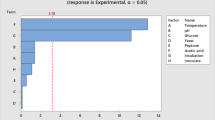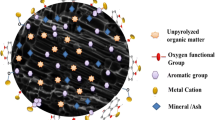Abstract
The initial decomposition rates of cellulose and hemicellulose were measured using toluene to specifically inhibit the microbial uptake of hydrolysis products during the degradation of newspaper under sulfate reducing and methane producing conditions. The amount of glucose and xylose accumulation in the first 2 weeks of incubation period was higher in the sulfate reducing condition compared to the methane producing condition. It was estimated that 28 and 6% of initially loaded cellulose in the sulfate reducing condition and the methane producing condition was hydrolyzed, respectively. Accordingly, the newspaper-cellulose hydrolysis rate constant was estimated to be 6.7 times higher in sulfate reducing condition than in methane producing condition. Based on the glucose accumulation patterns, when sulfate reducing bacteria (SRB) were inhibited by anthraquinone and molybdate (Na2MoO4), it may be suggested that SRB might have contributed to the hydrolysis of cellulose, while their effect on the hydrolysis of hemicellulose could not be elucidated.
Similar content being viewed by others
References
Al-Khafaji AW & Tooley JR (1986) Numerical Methods in Engineering Practice. CBS Publishing Japan Ltd., Japan
Bak F & Pfennig N (1991) Sulfate-reducing bacteria in littoral sediment of Lake Constance. FEMS Microbiol. Ecol. 85: 43–52
Benner R, Maccubbin AE & Hodson RE (1984) Preparation, characterization and microbial degradation of specifically radiolabeled [14C]lignocelluloses from marine and freshwater macrophytes. Appl. Environ. Microbial. 47: 381–389
Billen G (1982) Modeling the process of organic matter degradation and nutrient recycling in sedimentary systems. In: Nedwell DB & Brown CM (Eds), Sediment Microbiology (pp. 15–52). Academic Press, NY
Bisaria VS & Ghose TK (1981) Biodegradation of cellulosic materials: Substrates, microorganisms, enzymes, and products. Enzyme Microb. Technol. 3: 90–104
Boschker HTS, Bertilsson SA, Dekkers EMJ & Cappenberg TE (1995) An inhibitor-based method to measure initial decomposition of naturally occurring polysaccharides in sediments. Appl. Environ. Microbiol. 61: 2186–2192
Cooling FBIII, Maloney CL, Nagel E, Tabinowshi J & Odom JM (1996) Inhibition of sulfate & respiration by 1,8–dihydroxy anthraquinone and other anthraquinone derivatives. Appl. Environ. Microbiol. 62: 2999–3004
Cummings SP & Stewart CS (1994) A study of cellulose degradation in landfills (p. 23). ESTU B/B2/00198/REP UK.
DeBlois S & Wiegel J (1990) Hemicellulose in lignocellulose degradation. In: Akin DE et al. (Eds), Microbial and Plant Opportunities to Improve Lignocellulose Utilization by Ruminants (pp. 275–287). Elsevier, NY
Felix HR (1982) Permeabilized cells. Anal. Biochem. 120: 211–234
Gupta M, Sharma D, Suidan MT & Sayles GD (1996) Biotransformation rates of chloroform & under anaerobic conditions-II: Sulfate reduction. Wat. Res. 30: 1387–1394
Henrichs SM (1992) Early diagenesis of organic matter in marine sediments: progress and perplexity. Mar. Chem. 39: 119–149
Higuchi T (1985) Biosynthesis of lignin. In: Higuchi T (Ed), Biosynthesis and Biodegradation of Wood Components. Academic Press, Tokyo
Hyodo F, Azuma J-I & Abe T (1999) Estimation of effect of passage through the gut of a lower termite, Coptotermes Formosanus Shiraki on lignin by solid state CP/MAS 13C NMR. Holzforschung 53: 244–246
Hordjik KA, Harenaars CPMM & Cappenberg TE (1985) Kinetic studies of bacterial sulfate reduction in freashwater sediments by high-pressure liquid chromatography and distillation. Appl. Environ. Mocrobiol. 49: 434–440
Ingvorsen K & Brock TD (1982) Electron flow via sulfate reduction and methanogenesis in hypolimnion of lake Mendota. Limnol. Oceanogr. 27: 559–564
Ingvorsen K, Zehnder AJB & Jorgensen BB (1984) Kinetics of sulfate and acetate uptake by Desulfobacter postgatei. Appl. Environ. Microbiol. 47: 403–408
Jørgensen BB (1982) Mineralization of organic matter in the sea bed-the role of sulfate reduction. Nature 296: 643–645
King GM (1986) Characterization of β-glucosidase activity in intertidal marine sediments. Appl. Environ. Microbiol. 44: 1308–1317
Ljungdahl LG & Eriksson K-E (1985) Ecology of microbial cellulose degradation. Adv. Microb. Ecol. 8: 237–299
Lovely DR, Dwyer DF & Klug MJ (1982) Kinetic analysis of competition of sulfate reducers and methenogens for hydrogen in sediments. Appl. Environ. Microbiol. 43: 1373–1379
Magee RJ & Kosaric N (1985) Bioconversion of hemicellulosics. Adv. Biochem. Eng./Biotechnol. 32: 61–93
Owen WF, Stuckey DC, Healy J B, Young LY & McCarty PL (1979) Bioassay for monitoring biochemical methane potential and anaerobic toxicity. Wat. Res. 13: 485–492
Pareek S, Matsui S, Kim S K, and Shimizu Y (1998)Biodegradation of lignocellulosic material under sulfidogenic and methanogenic conditions in the landfill column reactors. Environ. Tech. 19: 253–261
Reis MAM, Almeida JS, Lemos PC & Carrondo MJT (1992) Effect of hydrogen sulfide on growth of sulfate reducing bacteria. Biotech. Bioeng. 40: 593–600
Speece RE (1996) Anaerobic biotechnology for industrial wastewaters (p. 310). Archae Press, Nashville.
Webster JR & Benfield EF (1986) Vascular plant breakdown in freshwater ecosystems. Annu. Rev. Ecol. Syst. 17: 567–594
Author information
Authors and Affiliations
Rights and permissions
About this article
Cite this article
Pareek, S., Azuma, JI., Shimizu, Y. et al. Hydrolysis of newspaper polysaccharides under sulfate reducing and methane producing conditions. Biodegradation 11, 229–237 (2000). https://doi.org/10.1023/A:1011141725511
Issue Date:
DOI: https://doi.org/10.1023/A:1011141725511




